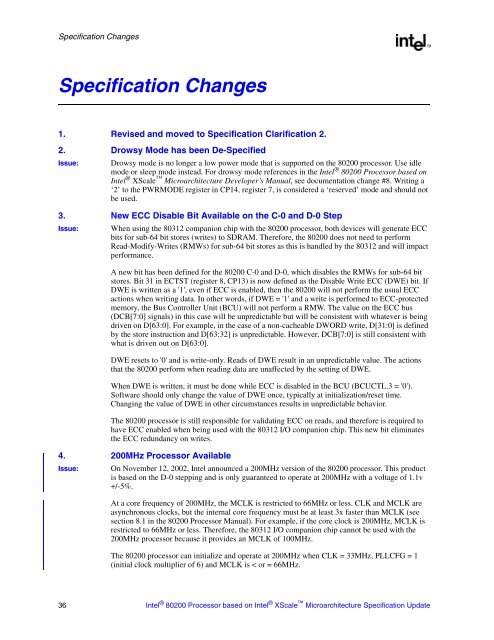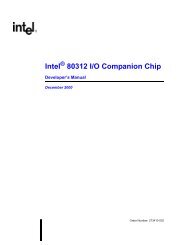Intel 80200 Processor based on Intel XScale Microarchitecture
Intel 80200 Processor based on Intel XScale Microarchitecture
Intel 80200 Processor based on Intel XScale Microarchitecture
Create successful ePaper yourself
Turn your PDF publications into a flip-book with our unique Google optimized e-Paper software.
Specificati<strong>on</strong> ChangesSpecificati<strong>on</strong> Changes1. Revised and moved to Specificati<strong>on</strong> Clarificati<strong>on</strong> 2.2. Drowsy Mode has been De-SpecifiedIssue: Drowsy mode is no l<strong>on</strong>ger a low power mode that is supported <strong>on</strong> the <str<strong>on</strong>g>80200</str<strong>on</strong>g> processor. Use idlemode or sleep mode instead. For drowsy mode references in the <str<strong>on</strong>g>Intel</str<strong>on</strong>g> ® <str<strong>on</strong>g>80200</str<strong>on</strong>g> <str<strong>on</strong>g>Processor</str<strong>on</strong>g> <str<strong>on</strong>g>based</str<strong>on</strong>g> <strong>on</strong><str<strong>on</strong>g>Intel</str<strong>on</strong>g> ® <strong>XScale</strong> <strong>Microarchitecture</strong> Developer’s Manual, see documentati<strong>on</strong> change #8. Writing a‘2’ to the PWRMODE register in CP14, register 7, is c<strong>on</strong>sidered a ‘reserved’ mode and should notbe used.3. New ECC Disable Bit Available <strong>on</strong> the C-0 and D-0 StepIssue: When using the 80312 compani<strong>on</strong> chip with the <str<strong>on</strong>g>80200</str<strong>on</strong>g> processor, both devices will generate ECCbits for sub-64 bit stores (writes) to SDRAM. Therefore, the <str<strong>on</strong>g>80200</str<strong>on</strong>g> does not need to performRead-Modify-Writes (RMWs) for sub-64 bit stores as this is handled by the 80312 and will impactperformance.A new bit has been defined for the <str<strong>on</strong>g>80200</str<strong>on</strong>g> C-0 and D-0, which disables the RMWs for sub-64 bitstores. Bit 31 in ECTST (register 8, CP13) is now defined as the Disable Write ECC (DWE) bit. IfDWE is written as a '1', even if ECC is enabled, then the <str<strong>on</strong>g>80200</str<strong>on</strong>g> will not perform the usual ECCacti<strong>on</strong>s when writing data. In other words, if DWE = '1' and a write is performed to ECC-protectedmemory, the Bus C<strong>on</strong>troller Unit (BCU) will not perform a RMW. The value <strong>on</strong> the ECC bus(DCB[7:0] signals) in this case will be unpredictable but will be c<strong>on</strong>sistent with whatever is beingdriven <strong>on</strong> D[63:0]. For example, in the case of a n<strong>on</strong>-cacheable DWORD write, D[31:0] is definedby the store instructi<strong>on</strong> and D[63:32] is unpredictable. However, DCB[7:0] is still c<strong>on</strong>sistent withwhat is driven out <strong>on</strong> D[63:0].DWE resets to '0' and is write-<strong>on</strong>ly. Reads of DWE result in an unpredictable value. The acti<strong>on</strong>sthat the <str<strong>on</strong>g>80200</str<strong>on</strong>g> perform when reading data are unaffected by the setting of DWE.When DWE is written, it must be d<strong>on</strong>e while ECC is disabled in the BCU (BCUCTL.3 = '0').Software should <strong>on</strong>ly change the value of DWE <strong>on</strong>ce, typically at initializati<strong>on</strong>/reset time.Changing the value of DWE in other circumstances results in unpredictable behavior.The <str<strong>on</strong>g>80200</str<strong>on</strong>g> processor is still resp<strong>on</strong>sible for validating ECC <strong>on</strong> reads, and therefore is required tohave ECC enabled when being used with the 80312 I/O compani<strong>on</strong> chip. This new bit eliminatesthe ECC redundancy <strong>on</strong> writes.4. 200MHz <str<strong>on</strong>g>Processor</str<strong>on</strong>g> AvailableIssue: On November 12, 2002, <str<strong>on</strong>g>Intel</str<strong>on</strong>g> announced a 200MHz versi<strong>on</strong> of the <str<strong>on</strong>g>80200</str<strong>on</strong>g> processor. This productis <str<strong>on</strong>g>based</str<strong>on</strong>g> <strong>on</strong> the D-0 stepping and is <strong>on</strong>ly guaranteed to operate at 200MHz with a voltage of 1.1v+/-5%.At a core frequency of 200MHz, the MCLK is restricted to 66MHz or less. CLK and MCLK areasynchr<strong>on</strong>ous clocks, but the internal core frequency must be at least 3x faster than MCLK (seesecti<strong>on</strong> 8.1 in the <str<strong>on</strong>g>80200</str<strong>on</strong>g> <str<strong>on</strong>g>Processor</str<strong>on</strong>g> Manual). For example, if the core clock is 200MHz, MCLK isrestricted to 66MHz or less. Therefore, the 80312 I/O compani<strong>on</strong> chip cannot be used with the200MHz processor because it provides an MCLK of 100MHz.The <str<strong>on</strong>g>80200</str<strong>on</strong>g> processor can initialize and operate at 200MHz when CLK = 33MHz, PLLCFG = 1(initial clock multiplier of 6) and MCLK is < or = 66MHz.36 <str<strong>on</strong>g>Intel</str<strong>on</strong>g> ® <str<strong>on</strong>g>80200</str<strong>on</strong>g> <str<strong>on</strong>g>Processor</str<strong>on</strong>g> <str<strong>on</strong>g>based</str<strong>on</strong>g> <strong>on</strong> <str<strong>on</strong>g>Intel</str<strong>on</strong>g> ® <strong>XScale</strong> <strong>Microarchitecture</strong> Specificati<strong>on</strong> Update
















